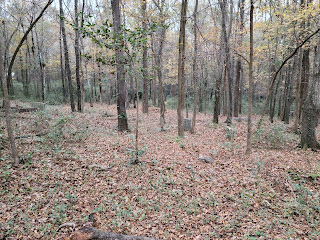Ol' Br'er has told stories several times about a family cemetery that Pappa Br'er only learned bout just before Br'er was born. That cemetery has an aunt and uncle who died as infants (a sister of and twin of Pappa Br'er's father), and is a few hundred yards away from the homesite where Pappa Br'er's father and siblings were born.
And, there is a family (husband - Harrison Lane, wife, and infant daughter) in the cemetery that Br'er cannot find anything linking them to his family. How and why they came to rest here is a mystery.
More to the point, Br'er has a 3rd Great-Grandfather buried there. And it is on what was his land that the cemetery sits. That gentleman is Arthur W Smith. And he is a brick wall in the genealogy work. The only thing known about his parents is his mother's first name and, based on census records, Arthur and his mother were born in Virginia.
Well, Ol' Br'er had a notion that maybe - just maybe - Arthur obtained the land from his father. And, maybe there would be a record of the land transfer. Naturally, these records only exist in the basement of the county courthouse an hour and a half away from the home warren. Even more fun, these are from the early years of the county (late 18th through mid 19th century) and are handwritten. Rapture! (Where is that sarcasm font?) The plan, then, was set to head down and trace the land ownership back to see from whom Arthur obtained it.
To paraphrase the illustrious "Doctor" Theodore Geisel - Dr. Seuss as you probably know him - "Oh! The revelations you will find!"
If you have never dealt with these old records, picture the massive tome a wizard would pull out to find an arcane spell in a movie. Some of them weigh more than 25lbs! Ol' Br'er seriously wondered if he needed a truss to carry them around! And, yes, they are DUSTY! Ol' Br'er's allergies were on full display. The sounds of sneezing and wheezing coming from that basement had to be alarming.
Should a body ever want to induce eye strain then they could scarcely do better than reading 18th and 19th century handwritten documents under poor lighting conditions. And the longer one spends doing this, the stronger the strain.
Br'er spent almost 8 hours reading the damned things.
Worse, he learned that Arthur did not get the land from his father. The brick wall stands firm, dammit. No, he bought the land from a man who purchased it a few years before from the son out of his father's estate.
Want to take a stab at whose estate the land came from?
Yup. One Harrison Lane (deceased). This answers the nagging question of how the Lanes came to be buried in the Smith Cemetery when they were not related to the family at all, not even tangentially. They were there first. So, by all rights, the cemetery should be the Lane Cemetery. Or perhaps the Lane-Smith Cemetery19th-century. This is not something anyone knew (or recalled), not even the county Historical Society.
Great. Now Br'er gets the joy of submitting an update to the cemetery description in Find A Grave. At this point, with the story being decades set in stone (so to speak), this is going to ruffle some feathers.
Having all this new information is a good thing to be sure. But not finding any answers that all the effort was supposed to uncover? That is maddening. As is the fact that, based on the date Arthur purchased the land, a few people presumed buried in an unmarked grave in this cemetery logically are not. They died before Arthur owned the land, so, logically, must be somewhere else. Damn.
In the end, the search remains as it started. There is nothing about Arthur's father - if he came to Georgia, or when he was born and died. To say nothing of his name! Hell, there isn't even anything on the family at all until 1840 by which time Arthur was almost 30 years old.
Of course, having the surname of Smith means searching for the father is kind of like searching for a needle in a stack of needles.

























